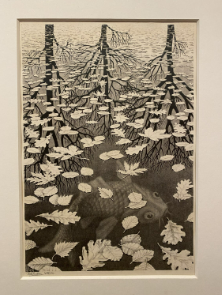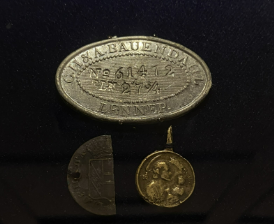The Museum of the Innocents: Jan Term in Italy
By Kaitlyn Mahoney, ‘26, and Annabelle Peebles, ‘26

On our last day in Florence, Italy, the Honors group visited the Museum of the Innocents, also known as the Hospital of the Innocents. A deeply emotional experience, the museum offered incredible insight as to what life might have been like for children whose families were unable to take care of them while the hospital was still in operation. Well-kept records and well-preserved artifacts were on display for all to see, telling tales of sorrowful loneliness and joyful reunions.
The extensive history of the museum is displayed along the walls of the first level, along with stories of some of the children who called the hospital their home. The museum, which originated in the 15th century during the early Renaissance, allowed for children to grow, learn, and appreciate art. The orphanage’s wheel system outside of the loggia allowed for “no questions asked” drop offs up until 1875, when the hospital stopped taking in children due to heavy financial debt. This debt was accrued due to famine hitting Italy, as well as a rising population and price of wheat. Even now the Museum aids struggling mothers and children, as well as promotes children’s rights. The museum also now houses a UNICEF Research center.
One of the most impactful spots within the museum was the drawers housing several belongings of the children who were left behind. Parents would often leave their kids with unique objects, or halves of common objects, in hopes that they would someday reunite with their children. One story that was particularly impactful was that of Flora, whose mother left her half of a golden cross and a beautiful poem. Two years later her mother was able to recognize her, and they were reunited. Those who remained at the institution were put to work in order to fit back into society. Women were trained in sewing and house-making duties with the intent of finding husbands, while men were educated and taught labored tasks. Women who chose to not marry either became nuns or were taught trade and manual labor.
The art within the museum was donated and commissioned by wealthy donors, such as the Silk Guild, in order to give the children the opportunity to learn. Art was highly valued at this institution and even now the museum reflects such. The Escher exhibit is an awe-inspiring demonstration of the type of art that the children would have been entertained and impressed by. Although the Escher exhibit was far more modern than the art the children would have viewed, the artwork poses as a wonderful reminder of the type of excitement children at the time may have felt when viewing the art. The exhibit features interactive art and demonstrations of some of the mind-bending, three-dimensional art that inspired and was inspired by Escher, as well as some of his own.
After you are finished on the first floor, you will walk up a flight of stairs to reach the second level. This floor contains two outdoor courtyards, one for men and one for women, and a small gift shop where you can buy some items pertaining to the history of the museum, though it is mostly merchandise for the Escher exhibit. The two courtyards are open-air and is where residents of the hospital would gather and spend time together. The men’s courtyard is significantly larger than the women’s courtyard and is more intricately designed. Both courtyards have signs at their entrances detailing the history of their construction and the purposes for which they were built.
As you walk up to the third floor to reach a small art exhibit, you will hear the pitter-patter of small feet and the sweet sound of children’s laughter. Writing on the wall of the staircase explains that the voices are from archives the hospital kept, though realistically the recording is much more recent. When you reach the top of the staircase, you will be greeted with a long hallway. Sculptures and paintings by artists such as Brunelleschi line the walls of the hallway, each centering around either religion or children, though often it is a mix of both. Two original i putti, which are swaddled infants that are often found in Renaissance art, hang on the far left wall. The i putti became a symbol of the hospital in its earlier days, a symbol of their dedication to helping those less fortunate and unable to fend for themselves.
As you continue through the exhibit, you will find two smaller rooms; one is filled with centuries-old books and music, and the other contains old dolls and figures that once resided in the hospital. In the front corner of the room is a small scene where a mannequin that wears an old nurse’s uniform stands before a painting and an altar, clearly showing what it might have looked like for a nurse to stop and say a prayer to St. Mary before continuing to care for the children at the hospital. The room even contains a set of bones, which are on display in a beautiful glass case.


